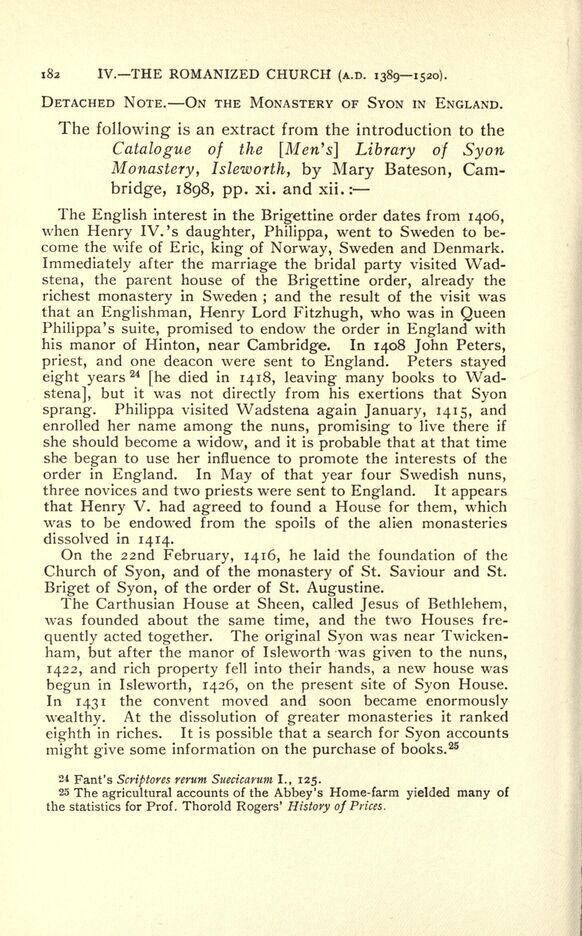
Full resolution (JPEG) - On this page / på denna sida - IV. The Romanized Church under the Union Sovereigns (1389—1520 A.D.) - The Birgittine Monastery of Syon in England

<< prev. page << föreg. sida << >> nästa sida >> next page >>
Below is the raw OCR text
from the above scanned image.
Do you see an error? Proofread the page now!
Här nedan syns maskintolkade texten från faksimilbilden ovan.
Ser du något fel? Korrekturläs sidan nu!
This page has never been proofread. / Denna sida har aldrig korrekturlästs.
x82 IV. THE ROMANIZED CHURCH (A.D. 13891520).
DETACHED NOTE. ON THE MONASTERY OF SYON IN ENGLAND.
The following is an extract from the introduction to the
Catalogue of the [Men s] Library of Syon
Monastery, Isleworth, by Mary Bateson, Cam
bridge, 1898, pp. xi. and xii.:
The English interest in the Brigettine order dates from 1406,
when Henry IV. s daughter, Philippa, went to Sweden to be
come the wife of Eric, king of Norway, Sweden and Denmark.
Immediately after the marriage the bridal party visited Wad-
stena, the parent house of the Brigettine order, already the
richest monastery in Sweden ;
and the result of the visit was
that an Englishman, Henry Lord Fitzhugh, who was in Queen
Philippa s suite, promised to endow the order in England with
his manor of Hinton, near Cambridge. In 1408 John Peters,
priest, and one deacon were sent to England. Peters stayed
eight years
24
[he died in 1418, leaving many books to Wad-
stena], but it was not directly from his exertions that Syon
sprang. Philippa visited Wadstena again January, 1415, and
enrolled her name among the nuns, promising to live there if
she should become a widow, and it is probable that at that time
she began to use her influence to promote the interests of the
order in England. In May of that year four Swedish nuns,
three novices and two priests were sent to England. It appears
that Henry V. had agreed to found a House for them, which
was to be endowed from the spoils of the alien monasteries
dissolved in 1414.
On the 22nd February, 1416, he laid the foundation of the
Church of Syon, and of the monastery of St. Saviour and St.
Briget of Syon, of the order of St. Augustine.
The Carthusian House at Sheen, called Jesus of Bethlehem,
was founded about the same time, and the two Houses fre
quently acted together. The original Syon was near Twicken
ham, but after the manor of Isleworth was given to the nuns,
1422, and rich property fell into their hands, a new house was
begun in Isleworth, 1426, on the present site of Syon House.
In 1431 the convent moved and soon became enormously
wealthy. At the dissolution of greater monasteries it ranked
eighth in riches. It is possible that a search for Syon accounts
might give some information on the purchase of books. 25
24 Pant s Scriptores renim Suecicarum I., 125.
25 The agricultural accounts of the Abbey s Home-farm yielded many of
the statistics for Prof. Thorold Rogers History of Prices.
<< prev. page << föreg. sida << >> nästa sida >> next page >>